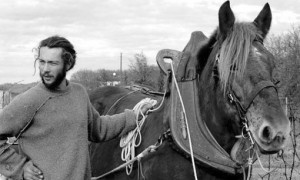It’s hardly surprising that most good winemakers are out of touch with popular opinion. Their balance sheets no doubt demonstrate that the public’s interest in natural wines has increased, but beyond that, little is understood about what exactly pleases a regular person. As far as we are concerned, it’s better this way. In all fields of artistic practice, practitioners have their own rules, rites of passage, and criteria for evaluating one another’s work; they also have their own heroes. One of the most interesting things to ask a winemaker is the seemingly mundane question of what they drink when the tourists aren’t around. This is how we learned about Simon Busser, whose bottles kept showing up on the tables of our favorite vignerons.
Along a meandering stretch of the Lot river outside Cahors, Simon farms around 5 hectares of Côt, Merlot and Chenin Blanc inherited from his father, along with a sprinkling of Trousseau and Savignin brought from friends in the Jura. Equidistant from the Mediterranean sun and the rainy Atlantic of France, Cahors is a region known for earthy and powerful red wines designed for the table. Practicing organic viticulture with a horse-drawn plough and zero-additive winemaking since 2008, Simon describes his style as “traditional” and “non-technical.”
For Simon, traditional refers to a combination of ripe grapes, significant extraction, and then elevage in large wood or concrete vessels—a style that he learned from his father and neighbors in Praysac. Non-technical, though we often hear it invoked by winemakers, has a bit more complicated, quasi-paradoxical meaning. As in cooking where simple dishes with few ingredients—imagine an omelette, a sole meunière, cacio e pepe— require more rigorous practice and attention to detail than food made with tweezers, so in winemaking it is often more difficult to naturally vinify a traditional red than a cloudy pet-nat or an aromatic amber wine. It’s no wonder that most good chefs are more likely to have a steak frites on their night off than the newest tasting menu in town. In the present climate, where irony is often celebrated more than sincerity, it takes a good deal of nerve to do something simple and do it well, without yelling about it. In our view, Simon’s approach to winemaking will never go out of style because, like a good bistro, its objective is to nourish and bring people together at a table.

